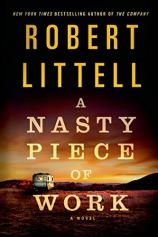A Nasty Piece of Work
Review
A Nasty Piece of Work
Robert Littell is arguably best known for THE COMPANY, a dog-knocker of an espionage novel published in 2002 that mixed history with fiction and made the former more believable. However, Littell was well known to readers of thrillers before and since for having compiled an enviable qualitative canon of books over the course of four decades.
Interestingly enough, his latest effort, A NASTY PIECE OF WORK, is different from THE COMPANY and just about everything else he has published thus far. To wit, it clocks in at well under 300 pages (but, in a very good and wonderful way, seems longer) and concerns a private investigator rather than spies. It also (except in flashback) eschews foreign ports of call for domestic ones. Readers familiar with Littell will marvel at his range, while newcomers will seek out his backlist.
A NASTY PIECE OF WORK contains just about every cliche associated with noir private-eye fiction --- from Gunn’s persona as a rumpled white knight to the alluring and potentially dangerous damsel in distress to the flawed hero making a deal with at least one devil. What is impressive here is that Littell takes these elements and makes them his own to the extent that by the time one reaches the point in the book where it would be reasonable to anticipate the arrival of such elements, the reaction upon same is delight, due to the manner in which they are presented.
"[A glossary] turns out not to be necessary here, thanks to Littell’s straightforward plotting and memorable characterization. All things considered, A NASTY PIECE OF WORK is a very fine piece of work, indeed."
That notwithstanding, Littell cannot resist a side visit into the world of spying and counterterrorism where he has previously made his bones. Private investigator Lemuel Gunn is an ex-CIA agent who was bounced from a field position in Afghanistan. He now works cheaply --- $95 a day --- out of a mobile home that he calls “Once in a Blue Moon” and has some historical importance of a sort. Gunn is stuck out of time, a courtly anachronism who eschews cell phones and has no idea what “googling” is.
As A NASTY PIECE OF WORK begins, Gunn is being retained by a new client, the attractive Ornella Neppi. The lady, who Gunn immediately nicknames “Friday,” is in a jam. It seems that she is a bail bondsman who has a client named Emilio Gava, who, from all indications, is about to skip out on his court appearance, leaving her holding a six-figure bag. Gunn begins investigating, but what he does not find is far more significant than what he does. Specifically, the guy is a ghost, an individual who people can only vaguely describe but who seems to have an aversion to having his picture taken. Worse, the police file on the cad is mysteriously missing. Gunn, assisted by Friday, follows the whisper of a trail to Nevada and Arizona, keeping old friends with some difficulty and making enemies along the way.
Before they are done, the FBI is involved, as well as a couple of mob families with conflicting interests and an uneasy truce that is a heartbeat away from being broken. And, of course, he is falling deep for Friday. You’ll be forgiven if you reach the conclusion before Gunn does that this is probably not a good idea, a state of affairs whose repercussions echo all the way to the conclusion of the book.
Irony abounds in A NASTY PIECE OF WORK. The traumatic experiences that have caused diversion in Gunn’s life during the past and present are eerily similar, not to mention that Gunn, when confronted with important choices, often makes the wrong one. These elements are the lagniappe to a wonderfully told tale that is both immediately familiar in form and unique in substance.
Littell also thoughtfully provides the reader with a section titled “The Principal Characters in This Book,” which lists just that and tells you exactly as much as you need to know about each of them, in the event that your one-sit reading is interrupted. Thank you, kind sir; those of us of a certain age occasionally forget who is doing what and to whom during the course of anything that exceeds 200 pages, so a glossary of this sort is most welcome. It turns out not to be necessary here, thanks to Littell’s straightforward plotting and memorable characterization.
All things considered, A NASTY PIECE OF WORK is a very fine piece of work, indeed.
Reviewed by Joe Hartlaub on November 27, 2013





